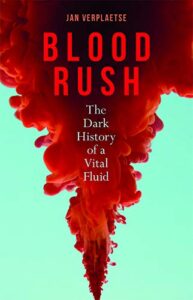 ( Bookshop.org | Amazon.com )
( Bookshop.org | Amazon.com )
Blood Rush: The Dark History of a Vital Fluid by Jan Verplaetse, translated by Andy Brown
Reaktion Books, 2020
ISBN: 978-1-78914-196-2
Available: Hardcover, Kindle edition
The scariest of Halloween costumes usually involve blood spattered on clothing, dripping down faces, or leaking out of fatal wounds. Likewise, detailed written descriptions of bloody murders that really took place or seeing that blood flow in a horror film can easily inspire terror and revulsion. So, it makes perfect sense that Jan Verplaetse would want, as he says in the subtitle of Blood Rush, to write “The Dark History of a Vital Fluid.” However, Verplaetse‘s ends up offering odd tidbits of information only to leave the reader wondering where it will all lead.
The book begins with the usual descriptions of and explanations for pagan sacrifices and winds its way to Christian transubstantiation. Along the way, we are regaled with stories of Christians accused of cannibalism, Odysseus’ trip to Hades, and the belief that epileptics could be cured by drinking fresh blood, usually procured from executed criminals or gladiators. This ancient time period provides everything from the author’s thoughts on blood sausage and pudding to demonic blood drinking. The focus on bloodlust, something the author tells us he experienced, and blood vapor or mist as the essence of the life force establish the dark underpinning of human interest, even attraction to, blood.
In contrast, the rest of the book does not progress in a way that would suggest there has been a development or a series of changes in the way humans perceive blood, nor are the examples of people and events particularly interesting. Instead, Verplaetse jumps from religious relics, to toxic menstrual blood and public slaughterhouses. Suddenly, the book seems to be about violence and then blood sports and “barbaric masculinity.” Can people really smell blood? Verplaetse experiments with its impact on gamers and decides the answer is no. Are cows upset by blood? He decides they are actually upset by what they are experiencing not the blood itself. “Why do we derive pleasure from the horrific?” he queries after summarizing the plot of Stoker’s Dracula for us.
By the end of the book, the theme as stated in the title is lost. It seems as though the research led Verplaetse in other directions, yet he continued to move forward without showing how his new findings tied into his original thoughts. However, there is promise in other possible themes he mentions like “dark romanticism” or the impact of myth and superstition as they relate to blood. In this sense, Blood Rush does not fulfill its potential.
Reviewed by Nova Hadley






Follow Us!